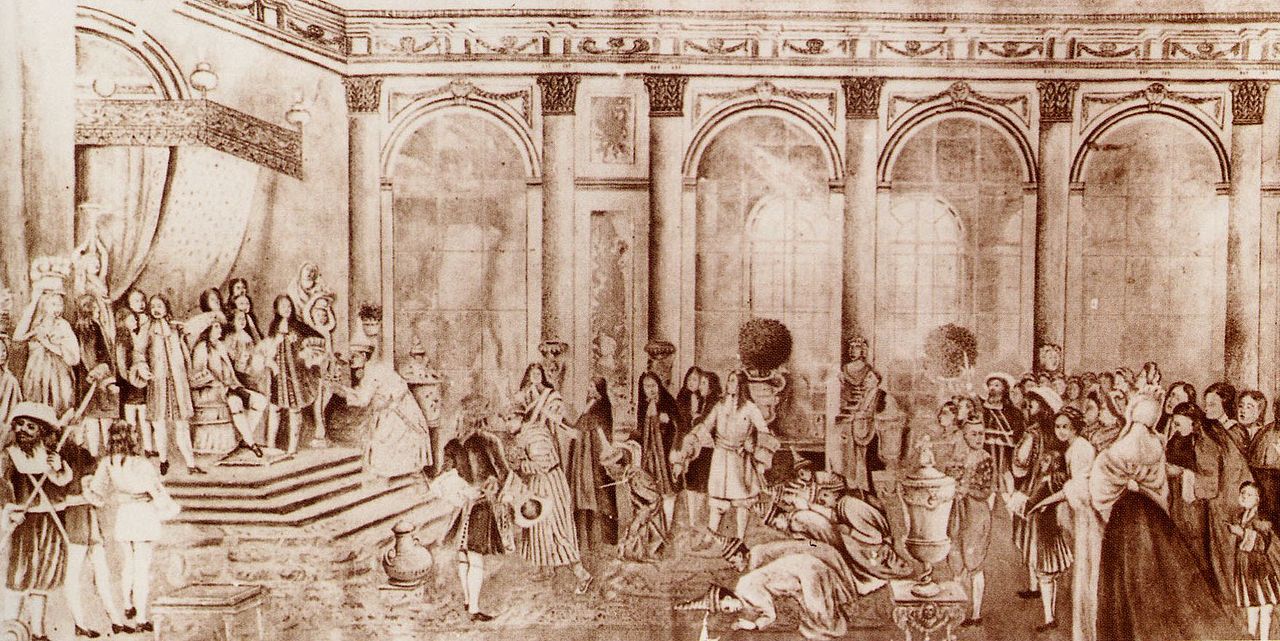In 1686 the King of Siam (Thailand today) sent his ambassador on his second visit to the court of France. The object of the visit was to form an "eternal alliance" between the two nations. Ambassadorial visits were not uncommon in Europe but it was rare that such exotic countries visited. As such it was a perfect occasion to demonstrate French power and prestige.
The ambassadors - of which there were three - were officially received by the King and his court on 1 September. They were accompanied by four gentlemen and two secretaries besides their private servants. They were fetched by the Marèchal de La Feuillade and rode in the carriages of the King and the Dauphine from their residence in Paris.
Once the carriages arrived at the courtyard of Versailles the ambassadors were met with by the sight of armed French and Swiss guards. From there they would proceed to the Ambassador's Staircase where they washed (a custom in Siam) and donned their "pyramid shaped" hats. These hats were adorned with rubies and thin leaves of gold.
 |
| Louis XIV enthroned before the ambassadors |
The ambassadors were led through the King's Grand Apartment and to the Hall of Mirrors. Here they faced an intimidating spectacle. On the far end of the Hall of Mirrors were the throne raised on a dais with Louis XIV's silver furniture on display. The dais was adorned with a Persian carpet while a golden canopy backed the throne; the canopy were embroidered with gold and silver threads in delicate floral patterns. The steps of the dais were flanked by silver candelabras.
The King remained sitting on his throne while the ambassadors made their slow process towards the throne; they stopped three times to bow. The King was not alone though; standing nearest to him were his descendants including his legitimised sons.
1500 aristocrats lined the halls of Versailles in their finest clothes and their most expensive jewels. The King himself was splendidly dressed. According to the Marquis de Sourches he was wearing "a coat of cloth-of-gold, laced with diamonds". Despite his glorious appearance the King's health was not as good as it used to be. He had recently undergone a surgery for a fistula. Actually, this surgery was the reason for the delay in the reception of the ambassadors; they had arrived in France already on 18 June.
 |
| This sketch clearly shows the layout of the reception |
When the three ambassadors reached the throne they threw themselves on the ground; it was custom in Siam at the time never to look a sovereign in the eye. Louis XIV graciously allowed them to raise their eyes and stand before him. The Abbé de Lyon acted as interpreter; the Marquis de Dangeau noted that the ambassadors only moved from their place in front of dais once: when they handed the letter from their King to Louis XIV. Even then they only stepped on the first step to the dais. The Marquis also noted that while the three ambassadors had all removed their hats out of respect the King kept his on - he only lifted it a few times. The audience being over the ambassadors walked back the same way the had come - backwards, so as to not turn their backs on the King.
The ambassadors were then treated by the King to a tour of his palace and its gardens. Following the tour one of the ambassadors exclaimed that he had hitherto known three wonders: Man, God and Paradise but now he knew a fourth: Versailles.
During the following days the ambassadors paid visits to the Grand Dauphin as well as other members of the royal family. One of these visits took them to Saint-Cloud where they were received by Philippe, Duc d'Orléans and Madame. However, they were not permitted to visit the Dauphine since she had recently given birth and was still in confinement.

It was custom to exchange gifts which was not ignored on this occasion. The ambassador brought exotic goods such as tortoise shell, woven fabrics, 1500 pieces of porcelain and pieces of lacquer furniture. The latter would become immensely popular in the following century. The King was even presented with two cannons which would be confiscated during the revolution to use in the storm of the Bastille. And then of course something that needed no translation: gold.
The ambassadors were deeply impressed with France and particularly the splendour of the court. No less than 4264 pieces of mirror was ordered to decorate the Siamese King's palace. As was 160 cannons, telescopes, glasses and two globes inscribed in Thai.
The ambassadors were not the only ones on a mission. Louis XIV had only recently concluded his war with the Netherlands and although the two powers were officially at peace they still kept an eye on each other. At the time the Netherlands made fortunes on trade with the Far East - trade that Louis XIV was eager to get his share off. So, the products ordered by the ambassadors were a part of an attempt to increase French trade with the Siamese King.
Not only trade was the object of the Sun King. Military support, too, were vital to the French King's foreign policies. However, the result was not quite as expected. Just two years later the Siamese King was overthrown and replaced by a man who closed all trade with westerners - except for the Dutch.

No comments:
Post a Comment